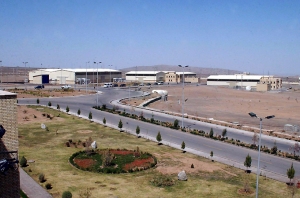 The Natanz enrichment complex.
The Natanz enrichment complex.
(UPDATED at 7:50pm EST)
By Peter Crail and Daryl G. Kimball
The latest quarterly IAEA report on Iran is now in circulation and provides an updated summary of Iran's nuclear activities and capabilities. The Feb. 24 report suggests that Iran is continuing to make steady progress expanding its enrichment capabilities, but it does not identify any breakthroughs. It also confirms initial impressions that Iran's announcements last week on a series of "nuclear advances" were hyped. Here is our brief summary of key takeaways:
Fordow Repurposed Again
The agency notes that Iran has now repurposed the Fordow enrichment plant three times. After saying last year that the plant would just be used to enrich uranium to 20%, it will now be enriching uranium to both 20% and 5%.
The rationale behind this repurposing is unclear, but it may signal an effort to maintain operations at the plant even if Iran agrees to an arrangement to halt 20% enrichment. Iranian officials said last year they would halt 20% enrichment if Iran received fuel for the Tehran Research Reactor (TRR).
Though it would be preferable to consolidate Iran's enrichment operations to Natanz, ending 20% enrichment is a far more important nonproliferation goal.
Iran has also installed two additional sets of IR-1 centrifuges at the Fordow plant and is installing the casings for IR-1 machines throughout the plant, according to the agency. This suggests that Iran's initial plans to fill the facility with its more advanced centrifuge models is not going to occur any time soon.
Scaling-Up at Natanz
The most significant step forward Iran appears to have achieved is increasing the number of centrifuges operating at its commercial-scale Natanz enrichment plant by 2,600 centrifuges since last November. Iran now has roughly 8,800 operating centrifuges at the facility, out of about 9,100 installed, which also represents a marked increase in the percentage of machines running. This increase enhances Iran's ability to produce low-enriched uranium at the plant.
Advanced Centrifuges
Iran has been testing its second-generation models for several years but they do not appear to be ready for full-scale use yet. Iran's ability to mass produce them is also uncertain.
After unveiling a third-generation centrifuge in 2010 and a fourth just recently, Iran seems to have just started preparing the way to test those models, called the IR-5, IR-6, and IR-6s. Given the time taken for R&D on Iran's second-generation machines, it probably quite some time before we see Iran ready these additional models for use.
Investigating Iran's Warhead Work
The IAEA and Iran are still discussing a way forward for the agency to investigate suspicions that Iran carried out work related to developing a nuclear warhead, which were detailed in the agency's November 2011 report.
Iran still is not cooperating fully with that investigation, and its denial of access to the Parchin complex is a missed opportunity to dispel concerns about possible military dimensions to its nuclear program. Those IAEA-Iran discussions should continue and focus on efforts to ensure that any warhead-related work that Iran carried out in have been, or will be halted, and will not occur in the future.
20% Fuel and the TRR
Iran announced last week that it had loaded fuel into the TRR and the agency's report confirms that, rather than fueling the reactor for operations, it is carrying out testing on fuel assemblies. Iran would need to carry out testing for some time before it could safely make the fuel itself. It would be safer for Iran, and in particular those living in the vicinity of the TRR, to receive fuel from abroad through an arrangement with the P5+1.
Although Iran has now produced about 110 kilograms of 20% enriched uranium, it has dedicated 8 kilograms to make fuel assemblies for the TRR. That material would no longer be part of a ready stockpile of 20% enriched uranium that can be rapidly converted to weapons-grade. Iran would need at least 120 kilograms of 20% material in order to make enough weapons grade uranium for a single weapon. It would want sufficient material for more than just one weapon if it were to decide to produce them.
Continuing the Diplomatic Track
The key parties must now get serious and pursue sustained negotiations aimed at ensuring that Iran meets its nonproliferation obligations. Another P5+1 round with Iran is a good start, but one high-profile meeting will not by itself likely produce a long-term deal that resolves the key issues. A number of proposals have been put forward that provide a good basis for progress.
In the near-term, the P5+1 should focus on arrangements that would end Iran's enrichment to 20%, which has no real justification and serves as a hedge to rapidly produce nuclear weapons. Reaching such an agreement can help to build confidence on both sides and reduce the risk of a dangerous military confrontation.
Both the U.S. administration and members of Congress have a role to play in increasing the possibility of an agreement and should refrain from any steps that would hinder it and increase the risk of war.
